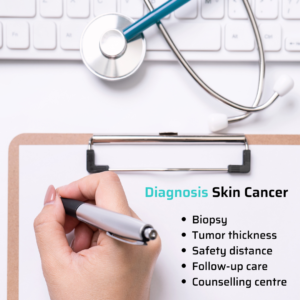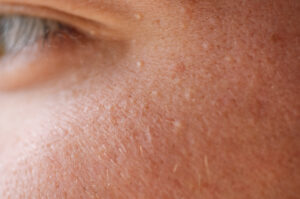Skin cancer almost always develops on the surface of the skin, making it visible and palpable. However, many of us do not know what the dangerous disease looks like and overlook the first signs. With a few tricks, even laymen can distinguish healthy skin changes from unhealthy ones and act quickly.
Once you have discovered a suspicious area of skin do not hesitate and go to the dermatologist to get an accurate diagnosis. The earlier skin cancer is detected, the greater the chances of cure.
Advantages of early detection
The main advantages of early detection of skin cancer can be easily illustrated. On the one hand, precancerous lesions are easier and better to treat than malignant skin tumours at a late stage. On the other hand, the earlier skin cancer is detected, the greater the chance of cure.
During the self-examination of the skin, which should be at least 2 times a year, you can examine moles for changes yourself. In addition, there is the possibility of a skin check by the dermatologist. In the process, all moles are examined in detail with a reflected-light microscope (dermatoscope). This modern examination method is completely painless and allows doctors to precisely analyze details of the surface of suspicious moles.
Furthermore, the earlier the diagnosis is made, the lower the cost of treatment, and thus the treatment to cure skin cancer can be started. The often associated costs are of great concern to those affected and their relatives. But doctors and insurance companies also advocate early detection, as it can save costs.
Features and symptoms of malignant melanoma
Melanoma skin cancer, also called malignant melanoma, is the most dangerous of all skin cancers. Malignant melanomas form metastases at an early stage which can spread throughout the body. At this late stage of the disease, it is often no longer curable.
Many young people are unaware of the risk and seriousness of this skin cancer. However, malignant melanoma is one of the most common tumours, especially in young people between 20 and 29 years of age.
How can I recognize malignant melanoma?
Precise andregular self-examination and observation of the skin enables early detection of malignant melanoma. The ABCDE rule helps you to recognize the dangerous skin cancer, because the characteristics are very typical for a malignant melanoma.
If one or more points apply to your moles, do not hesitate and contact a dermatologist.
ABCDE rule

Features and symptoms of non-melanoma skin cancer
Basal cell and squamous cell carcinoma are referred to as non-melanoma skin cancer. These types of skin cancer very rarely metastasize and are therefore almost always curable. Nevertheless, you should contact a dermatologist immediately at the first suspicion.
If the skin change is not recognized and removed in the early stages, a large tumor can grow that both expands in area and penetrates deep into the tissue.
How can I detect non-melanoma skin cancer?
Basal cell carcinoma and squamous cell carcinoma can basically develop anywhere on the body. The most commonly affected areas of the body are where the skin is frequently exposed to UV radiation. In addition to the head and neck area, the hands are also often affected.
Basal cell carcinoma, also called basal cell skin cancer, initially looks like a small, porcelain pimple that has tiny blood vessels on the surface. In the course of time, the surface of these skin units sinks in the middle and a hollow with a wall-like edge is formed. The surface of the trough is covered with crusts and may bleed repeatedly. The rim of the deepening is interspersed with small vessels.
The precursor of squamous cell carcinoma is actinic keratosis. In actinic keratosis, an adherent horny crust develops and grows continuously. If it is not treated, a squamous cell carcinoma develops after some time. The surface of the skin tumor feels like fine sandpaper, which is surrounded by a sharply defined redness.
Treatment
As with all types of skin cancer, only a tissue sample that is histologically examined can clarify whether the skin lesion is benign or malignant. Modern technologies support specialists in the diagnosis.
The annual examination of the entire body surface, also known as skin cancer screening, is enormously important for the early detection of skin cancer. Whether malignant or non-malignant skin cancer, the earlier it is detected and treated, the better the chances of cure.
Remember, you are in your skinfor life!







